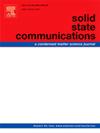(Sc,Nb)Fe2化合物磁性能的理论研究
IF 2.4
4区 物理与天体物理
Q3 PHYSICS, CONDENSED MATTER
引用次数: 0
摘要
本文对具有C14 mgzn2型结构的Sc1-xNbxFe2 (x = 0-0.6) Laves型金属间化合物的电子性能和磁性能进行了理论研究。铁6h原子形成两个kagom本文章由计算机程序翻译,如有差异,请以英文原文为准。
Theoretical investigations on the magnetic properties of the (Sc,Nb)Fe2 compounds
The theoretical investigations on the electronic and magnetic properties of the Sc1-xNbxFe2 (x = 0–0.6) Laves type intermetallic compounds with the C14 MgZn2-type structure are presented. The magnetic properties are determined by Fe 6h atoms forming two Kagomé hexagonal sublattices, separated by Fe 2a sites and Nb/Sc atoms in the interstices. ScFe2 is a ferromagnet, but Nb for Sc substitution reduces interatomic distances and promotes antiferromagnetic interaction between Fe spins. The present theoretical study may provide an insight into the influence of the chemical composition and interatomic spacing on the magnetic properties (magnetic moments, exchange-coupling parameters, and Curie temperatures) of the Sc1-xNbxFe2 series of compounds. The spin-polarized fully relativistic Korringa-Kohn-Rostoker (SPR-KKR) band structure method has been employed, using the coherent potential approximation (CPA) to deal with substitutional disorder. The available experimental data are used to give a more comprehensive description of the electronic and magnetic properties.
求助全文
通过发布文献求助,成功后即可免费获取论文全文。
去求助
来源期刊

Solid State Communications
物理-物理:凝聚态物理
CiteScore
3.40
自引率
4.80%
发文量
287
审稿时长
51 days
期刊介绍:
Solid State Communications is an international medium for the publication of short communications and original research articles on significant developments in condensed matter science, giving scientists immediate access to important, recently completed work. The journal publishes original experimental and theoretical research on the physical and chemical properties of solids and other condensed systems and also on their preparation. The submission of manuscripts reporting research on the basic physics of materials science and devices, as well as of state-of-the-art microstructures and nanostructures, is encouraged.
A coherent quantitative treatment emphasizing new physics is expected rather than a simple accumulation of experimental data. Consistent with these aims, the short communications should be kept concise and short, usually not longer than six printed pages. The number of figures and tables should also be kept to a minimum. Solid State Communications now also welcomes original research articles without length restrictions.
The Fast-Track section of Solid State Communications is the venue for very rapid publication of short communications on significant developments in condensed matter science. The goal is to offer the broad condensed matter community quick and immediate access to publish recently completed papers in research areas that are rapidly evolving and in which there are developments with great potential impact.
 求助内容:
求助内容: 应助结果提醒方式:
应助结果提醒方式:


